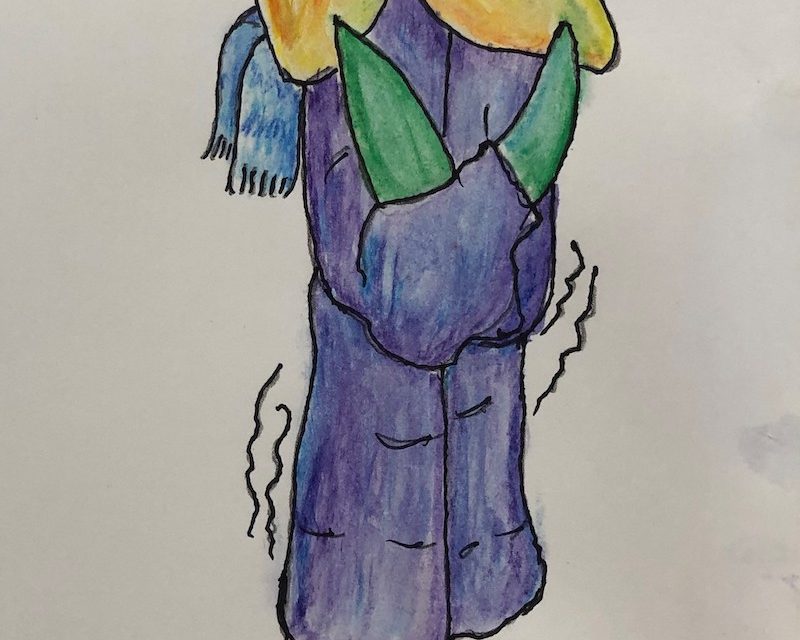
King Alfred Daffodil in Beaufort, illustration by Sondra Knight
Even the poets and writers disagree. So which is it – March or April? Louise Penny says March, and T. S. Eliot says April. My vote says March.
Why? Because it uses its mild days and nights to tease us that spring is here, only to drop its temperatures down to shiver, over and over again. All month. Down here in the Lowcountry, the last expected freeze date is March 19th. But it can be as early as February or as late as April. It’s not an exact science, you know. And with global warming, everything is up for grabs.
For us humans, it means only whether or not we put on an extra sweater or keep the parka out for another week or two. But it’s a matter of life and death for some plants – especially young ones and seedlings.
But the good news is that at least plants are not affected by the ‘wind chill’ or ‘real feel’ factor. When it’s 50 degrees, to a plant it will always be 50 degrees, regardless of other factors. Yes, winds can desiccate leaves, but that can happen in almost any temperature.
A late frost can kill newly emerging shoots, or at the very least, delay or eliminate the bloom for that year entirely. Winter blooming shrubs, like Camellias, can be in full and gorgeous bloom one day, and after a freezing night, be covered with brown and sad blossoms. Spring blooming bulbs are particularly susceptible. What to do?
Well, not much, as far as flowering shrubs are concerned. They’re usually too large to be covered with frost cloth, and since most are ground and not pot dwellers, they can’t be moved to shelter. So just enjoy what blooms they provide when they provide them, and wait until next year.
But that’s the thing, you know. We’re spoiled. We’ve been able to get around the discomforts of climate with heat and air conditioning, and we no longer have to limit our tables to seasonal produce. Strawberries in December? Of course.
Tropical fruit all winter? Why not?
Even plant hybridizers have been able to coax longer and repeated blooms from those that had only ‘seasonal’ blossoms. Encore Azaleas and Endless Summer Hydrangeas, for example. It wasn’t that long ago that our hearts leaped with joy and we knew spring had arrived when the Azaleas bloomed. Now? Ho Hum. They’ll be back again in a month or two . . .
Imagine if our favorite holidays happened several times a year. They would soon lose their unique luster and be viewed with much less anticipation. And like heat and air conditioning, would soon be taken for granted.
Let’s not forget April. It has its perils, too. The daytime temperatures are usually moderate, but we have to look out for the nighttime. Warm season vegetables, like tomatoes and peppers, for example, can’t be set out until nighttime temperatures are reliably over 50 degrees. Perennial and annual seeds are divided into two groups; tender and hardy. The tender ones, along with warm season vegetables, must bide their time in the greenhouse or on a window sill until the nights warm up. I know from sad experience that rushing to plant the seedlings you’ve nurtured all winter indoors can end in disaster if you don’t pay attention to the weather forecasts in April.
April has almost half the rainfall of March, but the soil temperature hasn’t heated up enough to need much supplemental water. Our wettest months are usually July and August.
It’s hard to tell when the seasons change here. We’re not warm enough to be reliably tropic, and we’re not cold enough to give our northern favorites the dormancy they need to re-bloom. We really can’t tell from zone maps if a particular plant will thrive here. It may be robust in your across-town friend’s yard, but simply a bust in yours.
Gardening is not entirely a guessing game. A well informed gardener will win far more often than lose. My mother used to console me after a failure, telling me that you never learn anything new by doing it right. Experience is a pretty reliable teacher, and each failure has taught you something.
But you don’t have to make all the gardening mistakes yourself before you can be a successful gardener. You can benefit from the mistakes of others. That’s what friends are for. Gardeners are among the most generous of hobbyists (I really don’t like to think that gardening is a hobby, although it fits the definition of something done for pleasure in leisure time). So many hobbies are competitive, but gardeners are sharers. I’ve never been refused a cutting or a few seeds if I ask, and I don’t usually have to ask. We’re almost as delighted with a neighbor’s success with a difficult plant as they are.
April is the month when we can be almost certain that there will be no more freezing weather. That doesn’t mean that we won’t have some gray and dreary days, but plants aren’t emotionally affected by them like we are. At least I don’t think so.
Like most things, every month has its pros and cons. Whatever else March and April bring, they bring with them the breath of the coming spring. And the whole world loves spring. Well, except for ski resorts.









